Juan De Fuca
-
- Nontank VRP Regs Maritime Reporter, Nov 2013 #20
The clock is ticking toward the deadline to submit to the U.S. Coast Guard an oil spill response plan that meets the requirements of the NTVRP regulation.
The long-awaited nontank vessel response plan (NTVRP) rulemaking was published on September 30, 2013 and came into effect on October 30, 2013. Neither of these are significant dates for the owners, operators, and masters of nontank vessels operating on the navigable waters of the United States. The truly significant date is January 30, 2014. This is the deadline for submittal to the US Coast Guard of an oil spill response plan that meets the requirements of the NTVRP regulation.
There are many good things about the NTVRP. Planning for oil spill response and preparation for an actual response effort are important and have been shown to ultimately reduce both the number and severity of oil spills.
Space limitations, though, prevent me from summarizing the details of this complex rulemaking. Instead, this article will have to focus on a few aspects of the rule where things have gone astray or there is room for improvement.
Wrapped Around the Axle
The Coast Guard has unfortunately gotten itself wrapped around the axle with regard to the geographic coverage of this regulation. Not inconsistently with the enabling legislation, the regulation states in new 33 CFR § 155.5015(a) that the NTVRP regulations apply to each self-propelled vessel that: (1) carries oil of any kind as fuel for main propulsion; (2) is not a tank vessel or is not certificated as a tank vessel; (3) operates upon the navigable waters of the United States, as defined in 46 U.S.C. 2101(17a); and (4) is 400 gross tons or more as measured under the convention measurement system in 46 U.S.C. 14302 or the regulatory measurement system of 46 U.S.C. 14502 for vessels not measured under 46 U.S.C. 14302. For this purpose, “navigable waters of the United States” means the territorial sea out to 12 nautical miles seaward of the baseline from which the territorial sea is measured and those internal waters subject to the ebb and flow of the tide and those non-tidal waters that either are historically navigable by interstate or foreign commerce or are navigable in fact.
The new NTVRP regulation then attempts to require that the oil spill response plans prepared for nontank vessels include response planning for waters in the offshore area and the open ocean area as defined in the original vessel response plan regulations. The original vessel response plan regulations were intended for use with regard to tank vessels.
The oil spill response plan requirement for tank vessels, as enacted in the Oil Pollution Act of 1990 (OPA 90), extended out to 200 nautical miles offshore. A vessel, other than a tank vessel, operating seaward of the navigable waters of the United States (as defined at 33 CFR § 155.5015(a)(3)), is just a vessel. By law, there is no such thing as a nontank vessel further offshore than 12 nautical miles. Therefore, the Coast Guard is acting outside its authority (i.e., in an ultra vires manner) when it purports to require nontank vessels (or at least foreign nontank vessels) to prepare and submit response plans that address a spill or the substantial threat of a spill that occurs more than 12 nautical miles offshore.
That said, it must be recognized that the owners and operators of all vessels (and facilities) from which oil is discharged without a permit are responsible under the law responding to that discharge if it occurs in waters subject to the jurisdiction of the United States, out to 200 nautical miles offshore. Only tank vessels are required by law to develop, implement, and submit for approval by the Coast Guard oil spill response plans for discharges more than 12 nautical miles offshore.
It behooves the owner or operator of a vessel other than a tank vessel to develop and implement a response plan covering discharges of oil more than 12 nautical miles offshore if the vessel regularly operates in waters more than 12 nautical miles offshore – but such a plan is not required by law.
Salvage and Marine Firefighting
The NTVRP regulations (and now the VRP regulations) include salvage and marine firefighting requirements. In this regard, the recent NTVRP rulemaking has wording that raises some questions.
The NTVRP regulation requires response plans for nontank vessels with a fuel capacity of 2,500 barrels or greater to “meet the salvage, emergency lightering, and marine firefighting requirements found in subpart I”. Subpart I, the salvage and marine firefighting regulations, in defining the term “assessment of structural stability”, requires that the assessment be consistent with the conditions set forth in 33 CFR § 155.240. This latter regulation requires, among other things, that vessel baseline strength and stability characteristics be pre-entered into a computerized, shore-based damage stability and residual structural strength calculation program. Numerous nontank vessels have not currently calculated their baseline strength and stability characteristics, let alone have those calculations pre-entered into a shore-based stability and strength calculation program.
If those characteristics were ever calculated, they generally have not been updated to account for changes and alterations made to the vessel. Thus, this regulatory requirement may impose an unanticipated burden on many owners and operators of covered nontank vessels. To make matters more confusing, new regulation 33 CFR § 155.5035(c)(11) provides that pre-entering of these characteristics is optional. Alternatively, the owner or operator of a nontank vessel may maintain ashore a copy of the vessel plans necessary to perform salvage, stability, and hull stress assessments. The Coast Guard may wish to clarify these provisions.
Nontank vessels with a fuel capacity of less than 2,500 barrels but greater than or equal to 250 barrels are not required to have salvage and marine firefighting contracts, but must plan for and identify salvage, emergency lightering, and marine firefighting resources and include in their plans a written consent for plan listing from the recognized response resource provider. In the NTVRP preamble, it states, in pertinent part, that the owners and operators of these nontank vessels must provide those resource providers with a copy of the nontank vessel’s pre-fire plan. The resource provider must agree that the pre-fire plan is acceptable and agree to implement it to mitigate a potential or actual fire. This language in the preamble seeks to impose a requirement that is not found in the actual rule.
Foreign Vessel Not in Innocent Passage
The NTVRP regulation clearly and correctly states that it is not applicable to a foreign-flag vessel engaged in innocent passage through the territorial sea or transit passage through a strait used for international navigation, unless that vessel is bound for or departing from a port or place of the United States. There is no mention, though, in the rulemaking about two specific geographic areas where this legalistic approach will create friction – the Great Lakes and the Strait of Juan de Fuca.
Waters of the Great Lakes are internal to the United States and Canada and the boundary in those Lakes is specifically defined. Because waters of the Great Lakes are internal, there is no right of innocent passage. A Canadian flag vessel operating on the US side of the Great Lakes boundary is required by US law and regulation to have a NTVRP (unless the two nations agree to an alternative approach). Likewise, a non-Canadian foreign vessel calling at a Canadian port in the Great Lakes is required to have a NTVRP, since it is physically impossible to enter the Great Lakes from the sea without going through some US waters.
With regard to the Strait of Juan de Fuca, the United States has long taken the position that the status of those waters is unique (i.e., sui generis) and that neither the concept of innocent passage nor the concept of transit passage applies. Thus, any nontank vessel bound to or from a port or place in British Columbia via the Strait of Juan de Fuca will be required to have a NTVRP if it operates on the US side of the international boundary. Since the US-Canada Cooperative Vessel Traffic Service for the Strait requires vessels in-bound through the Strait to stay on the south (US) side of that waterway, there is almost no way to avoid this situation.
A similar conundrum was encountered with regard to the US tank vessel response plan regulations in 1993. At that time (as I recall), the two nations agreed that their response plan requirements were functionally equivalent and vessels that compiled with Canadian response plan requirements were considered by the US Coast Guard to be in compliance with US VRP requirements. The same may not hold true now. The US has included such requirements as salvage and marine firefighting in its response plan regulations – requirements that are not included in the Canadian regulations. Thus, questions must be raised regarding vessels transiting US waters of the Great Lakes and the Strait of Juan de Fuca without a valid US NTVRP.
Conclusion
With the exceptions noted above, the new NTVRP regulation greatly improves the response readiness of nontank vessels with respect to oil spills in the navigable waters of the United States. Experience with tank vessels also shows that oil spill response planning helps to reduce the frequency and volume of oil spills. As the tanker industry learned, prevention is a lot less expensive than attempting to clean up afterwards.
Dennis L. Bryant,
Maritime Regulatory
Consulting, Gainsville, Fla.
t: 352-692-5493
e: [email protected](As published in the November 2013 edition of Maritime Reporter & Engineering News - www.marinelink.com)
-
- Passenger Catamaran To Operate Between Seattle And Victoria Maritime Reporter, Jun 1986 #24
decks are surrounded by large windows giving passengers nearly unobstructed views of the beautiful route up Puget Sound and across the Strait of Juan de Fuca. In addition, upper deck passengers will be able to watch the captain and crew at work during normal daylight operations through a glass wall
-
- FMC Launches Big Deck Barge For Puget Sound Freight Lines Maritime Reporter, Aug 1980 #34
landmarks, such as Cape Flattery, which is located on the e x t r e m e n o r t h w e s t corner of Washington State on the Strait of Juan de Fuca. "This (barge) goes into service as the largest and finest of our fleet," added Mr. Lovejoy. The Marine and Rail Equipment Division of FMC
-
- Canada's Largest OSRV Designed By MARCO Maritime Reporter, Mar 1992 #21
Burrard Clean Operations Limited, a Vancouver, B.C., cooperative. The vessel will be used to protect the often difficult waters of the Strait of Juan de Fuca. The second MARCO design for Burrard, the steel-hull vessel is 75 feet long, with a beam of 22 feet 6 inches and a depth of 9 feet 7 inches
-
- MBARI: Hydrothermal Mapping is Heating up Marine Technology, May 2020 #49
A recent paper by Monterey Bay Aquarium Research Institute (MBARI) has revealed almost 600 hydrothermal chimneys around the Endeavour Segment of the Juan de Fuca Ridge, about 350 kilometres (220 miles) northwest of Washington State. The vents, located in a valley about 14 kilometres (8.6 miles) long and 1
-
- Two Vessels Trucked To 'Sea' Maritime Reporter, Sep 15, 1981 #5
ramps on each and facilitate loading. From Everett, the 42-foot-wide, 120-footlong ferry proceeded under her own power through the Strait of Juan de Fuca to the Pacific Ocean and down the coast to the mouth of the Columbia River, then up the Columbia, passing through the locks of five dams. At
-
- Salvage and Marine Firefighting Maritime Reporter, Jul 2017 #12
resources may be located. Examples of such distant CONUS locations include, but are not limited to: Crescent City, Calif.; the entrance to the Strait of Juan de Fuca; Fort Pierce, Fla.; Bar Harbor, Maine; and many portions of the Great Lakes and Western Rivers. It is therefore recommended that the Coast Guard
-
- View from the Top: Dr. James Delgado, NOAA Director of Maritime Heritage Marine Technology, Sep 2016 #9
the southern west coast of Canada, where we have an interest, as does the province of British Columbia, in a World War II wreck located in the Strait of Juan de Fuca. Later, I’ll also be travelling to San Francisco where we’ll be doing deep-sea exploration, including what will be the first time we’ll be able
-
- OTC 84 Maritime Reporter, Apr 1984 #72
Combined Hot-Spot Stress Procedures for Tubular Joints • Marine Minerals Mining OTC 4776 Rift and Hydrothermal Venting Processes Along the Gorda-Juan de Fuca Ridge System 4777 Ore Assays of Massive Sulfides From Three Spreading Centers 4778 Geological Perspectives of Metalliferous Sulfides: Offshore
-
 )
March 2024 - Marine Technology Reporter page: 48
)
March 2024 - Marine Technology Reporter page: 48Index page MTR MarApr2024:MTR Layouts 4/4/2024 3:19 PM Page 1 Advertiser Index PageCompany Website Phone# 17 . . . . .Airmar Technology Corporation . . . . . . . . . .www.airmar.com . . . . . . . . . . . . . . . . . . . . . . . . . . . . . . . . .(603) 673-9570 9 . . . . . .Birns, Inc. . . . . . . . . . .
-
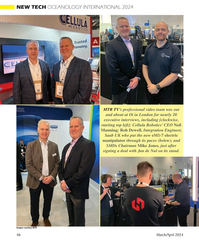 )
March 2024 - Marine Technology Reporter page: 46
)
March 2024 - Marine Technology Reporter page: 46NEW TECH OCEANOLOGY INTERNATIONAL 2024 MTR TV’s professional video team was out and about at Oi in London for nearly 20 executive interviews, including [clockwise, starting top left]: Cellula Robotics’ CEO Neil Manning; Rob Dewell, Integration Engineer, Saab UK who put the new eM1-7 electric manipulator
-
 )
March 2024 - Marine Technology Reporter page: 45
)
March 2024 - Marine Technology Reporter page: 45ronments. The new agreement will address speci? c techni- cal gaps in the UUV defense and offshore energy markets especially for long duration, multi-payload mission opera- tions where communications are often denied or restricted. As part of the new alliance, Metron’s Resilient Mission Autonomy portfolio
-
 )
March 2024 - Marine Technology Reporter page: 36
)
March 2024 - Marine Technology Reporter page: 36LANDER LAB #10 Of special interest for marine applications, LiPo batteries are Shipping any kind of lithium battery can be a challenge, and offered in a “pouch” design, with a soft, ? at body. The pouch IATA regs vary with the batteries inside or outside an instru- is vacuum-sealed, with all voids ?
-
 )
March 2024 - Marine Technology Reporter page: 33
)
March 2024 - Marine Technology Reporter page: 33regulated industry in the world.” How- ever, commercial success depends on many factors, not least a predictable OPEX. Over the past four years, SMD has worked with Oil States Industries to calculate cost per tonne ? gures for prospective customers. Patania II uses jet water pumps to Oil States’
-
 )
March 2024 - Marine Technology Reporter page: 27
)
March 2024 - Marine Technology Reporter page: 27SEA-KIT USV Maxlimer returning from HT-HH caldera in Tonga. © SEA-KIT International data and further assess ecosystem recov- ery. What is known, noted Caplan-Auer- bach, is that the impact of submarine vol- canoes on humans is rare. “The HT-HH eruption was a tragedy, but it was very unusual. It let us
-
 )
March 2024 - Marine Technology Reporter page: 11
)
March 2024 - Marine Technology Reporter page: 11assist in identifying mines and act as a neutralization device. About the Author Bottom mines pose even greater chal- David R. Strachan is a defense analyst and founder of lenges. Unlike contact mines, bottom Strikepod Systems, a research and strategic advisory mines utilize a range of sensors to
-
 )
March 2024 - Marine Technology Reporter page: 6
)
March 2024 - Marine Technology Reporter page: 6MTR Editorial Advisors Gallaudet Hardy The Honorable Tim Gallaudet, Kevin Hardy is President PhD, Rear Admiral, U.S. of Global Ocean Design, Navy (ret) is the CEO of creating components and Ocean STL Consulting and subsystems for unmanned host of The American Blue vehicles, following a career
-
 )
April 2024 - Maritime Reporter and Engineering News page: 35
)
April 2024 - Maritime Reporter and Engineering News page: 35SIMULATION e have a close relationship with tech- Realism is prized beyond immersive, photo-realistic visu- nology, evidenced by, for example, als, and providers are introducing increasingly accurate func- the phones we are estimated to un- tionality. FORCE Technology’s upcoming DEN-Mark2 math- lock around
-
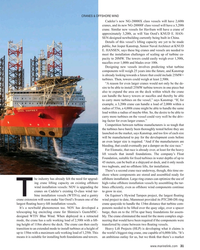 )
April 2024 - Maritime Reporter and Engineering News page: 31
)
April 2024 - Maritime Reporter and Engineering News page: 31CRANES & OFFSHORE WIND Cadeler’s new NG-20000X class vessels will have 2,600t cranes, and its new NG-20000F class vessel will have a 3,200t crane. Similar new vessels for Havfram will have a crane of approximately 3,200t, as will Van Oord’s KNUD E. HAN- SEN-designed newbuilding currently being built in
-
 )
April 2024 - Maritime Reporter and Engineering News page: 21
)
April 2024 - Maritime Reporter and Engineering News page: 21ROB LANGFORD, VP, GLOBAL OFFSHORE WIND ob Langford has worked in the offshore industry ABS. “We are growing and evolving our services across all for more than three decades, ‘cutting his teeth’ offshore infrastructure along with our continued support to the in a UK design ? rm working in the North Sea
-
 )
April 2024 - Maritime Reporter and Engineering News page: 14
)
April 2024 - Maritime Reporter and Engineering News page: 14Book Review Approach to Meeting Underwater Radiated Noise Limits Def ned By Raymond Fischer uantitative underwater radiated noise limits will construction inspections, 5) possible training with respect to be developed shortly by IMO, and/or countries salient design/construction essentials, 6) compliance
-
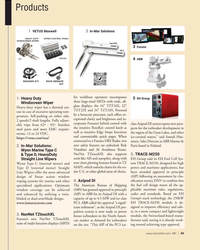 )
April 2024 - Marine News page: 43
)
April 2024 - Marine News page: 43Products 1 2 VETUS Maxwell In-Mar Solutions 3 Furuno ABB 4 for workboat operators encompasses EH Group 1. Heavy Duty 5 three large-sized MFDs with wide, all- Windscreen Wiper glass displays: the 16” TZT16X, 22” Heavy-duty wiper has a thermal cut- TZT22X and 24” TZT24X. Powered out in
-
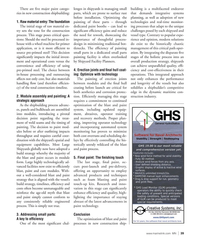 )
April 2024 - Marine News page: 39
)
April 2024 - Marine News page: 39There are ? ve major paint catego- lenges in shipyards is managing small building is a multifaceted endeavor ries in new construction shipbuilding: parts, which are prone to surface rust that demands integrative systems before installation. Optimizing the planning, as well as adoption of new 1.
-
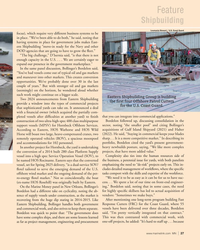 )
April 2024 - Marine News page: 27
)
April 2024 - Marine News page: 27Feature Shipbuilding Loumania Stewart / U.S. Coast Guard focus), which require very different business systems to be in place. “We’ve been able to do both,” he said, noting that having systems in place for government jobs makes East- ern Shipbuilding “move-in ready for the Navy and other DOD agencies
-
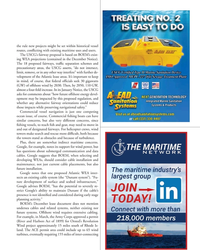 )
April 2024 - Marine News page: 23
)
April 2024 - Marine News page: 23the rule new projects might be set within historical vessel routes, con? icting with existing maritime uses and users. The USCG’s fairway proposal is based on BOEM’s exist- ing WEA projections (contained in the December Notice). The 18 proposed fairways, traf? c separation schemes and precautionary
-
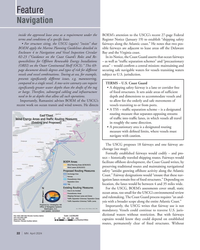 )
April 2024 - Marine News page: 22
)
April 2024 - Marine News page: 22Feature Navigation inside the approved lease area as a requirement under the BOEM’s attention to the USCG’s recent 27-page Federal terms and conditions of a speci? c lease. Register Notice (January 19) to establish “shipping safety • For structure siting, the USCG (again) “insists” that fairways along
-
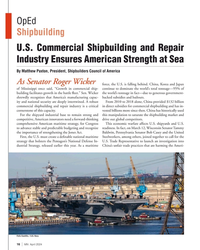 )
April 2024 - Marine News page: 16
)
April 2024 - Marine News page: 16OpEd Shipbuilding U.S. Commercial Shipbuilding and Repair Industry Ensures American Strength at Sea By Matthew Paxton, President, Shipbuilders Council of America As Senator Roger Wicker force, the U.S. is falling behind. China, Korea and Japan of Mississippi once said, “Growth in commercial ship-
-
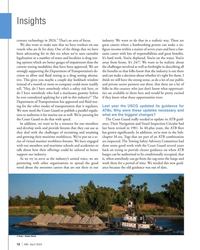 )
April 2024 - Marine News page: 12
)
April 2024 - Marine News page: 12of tell, “Hey, do I have somebody who’s a safety risk here, or folks in this country who just don’t know what opportuni- do I have somebody who had a marijuana gummy before ties are available to them here and would be pretty excited he ever considered applying for a job in this industry?” The if they knew
-
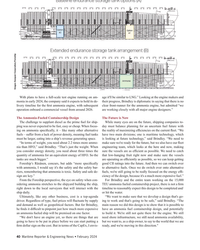 )
February 2024 - Maritime Reporter and Engineering News page: 40
)
February 2024 - Maritime Reporter and Engineering News page: 40Images Seaspan Corporation/Foreship With plans to have a full-scale test engine running on am- age it'll be similar to LNG.” Looking at the engine makers and monia in early 2024, the company said it expects to hold its de- their progress, Brindley is diplomatic in saying that there is no livery timeline
-
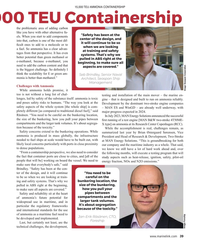 )
February 2024 - Maritime Reporter and Engineering News page: 39
)
February 2024 - Maritime Reporter and Engineering News page: 3915,000 TEU AMMONIA CONTAINERSHIP 000 TEU Containership the problematic area of adding carbon like you have with other alternative fu- “Safety has been at the els. When you start to add components center of the design, and into that, carbon is one of the most dif- it will continue to be so ? cult ones
-
 )
February 2024 - Maritime Reporter and Engineering News page: 36
)
February 2024 - Maritime Reporter and Engineering News page: 36HYBRID 2-stroke controllable pitch propeller PTO powertrain Source: MAN Energy Solutions how the system is intended to operate, says Oskar Levander, VP Strategy & Business Development, Kongsberg Maritime. For example, a primary shaft-driven PTO rotates whenever the engine is running; a secondary one
-
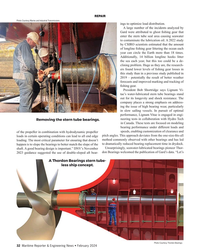 )
February 2024 - Maritime Reporter and Engineering News page: 32
)
February 2024 - Maritime Reporter and Engineering News page: 32REPAIR Photo Courtesy Marine and Industrial Transmissions ings to optimize load distribution. A large number of the incidents analyzed by Gard were attributed to ghost ? shing gear that enter the stern tube seal area causing seawater to contaminate the lubrication oil. A 2022 study by CSIRO scientists
-
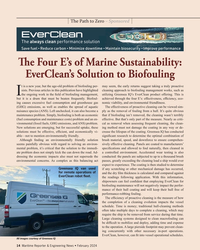 )
February 2024 - Maritime Reporter and Engineering News page: 14
)
February 2024 - Maritime Reporter and Engineering News page: 14The Path to Zero – Sponsored EverClean The always clean performance solution • • • • Save fuel Reduce carbon Minimize downtime Maintain biosecurity Improve performance T e Four E’s of Marine Sustainability: EverClean’s Solution to Biofouling t is a new year, but the age-old problem of biofouling per-
